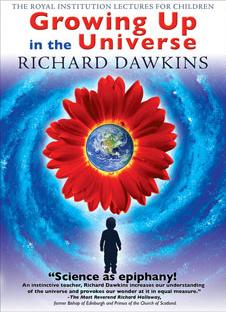Growing Up in the Universe
| Growing Up in the Universe | |
|---|---|

Cover of the DVD
|
|
| Written by | Richard Dawkins |
| Directed by | Stuart McDonald |
| Starring | Richard Dawkins |
| Music by | Roger Bolton |
| Country of origin | UK |
| Original language(s) | English |
| Production | |
| Producer(s) | William Woollard and Richard Melman for InCa Productions |
| Editor(s) | Roger Collings |
| Running time | 300 minutes |
| Distributor | Richard Dawkins Foundation for Reason and Science |
| Release | |
| Original release | 1991 (first broadcast) 30 April 2007 (DVD version) |
| Chronology | |
| Followed by | The Root of All Evil? |
Growing Up in the Universe was a series of lectures given by Richard Dawkins as part of the Royal Institution Christmas Lectures, in which he discussed the evolution of life in the universe.
The lectures were first broadcast in 1991, in the form of five one-hour episodes, on the BBC in the United Kingdom. The Richard Dawkins Foundation for Reason and Science was granted the rights to the televised lectures, and a DVD version was released by the foundation on 20 April 2007.
Dawkins' book Climbing Mount Improbable developed from the ideas presented in the lectures, and the title itself is taken from the third lecture in the series.
To start off part one, Dawkins discusses the amazing capabilities of the human body and contrasts these with the limited capabilities of computers and other man-made machines. He uses a small totem pole (which is used in ancestor worship) to illustrate the importance of studying our ancestors to understand how we've evolved. To contrast ease of reproduction with the difficulty of becoming an ancestor, Dawkins uses the example of paper folding to explain exponential growth. Dawkins then tells the audience that exponential growth does not generally happen in the real world - natural factors come into play which control the population numbers, meaning that only an elite group of organisms will actually become distant ancestors. To be in this elite group, the organism must "have what it takes" to survive and pass on their genes to offspring.
The long chain of successful ancestors means that the probability of our existence is very small, and we are lucky to be alive. By turning down the lights and shining a small spotlight on a large ruler in front of him, Dawkins illustrates the darkness of the distant past and of the unknown future.
After expounding on how lucky we are to be alive, and urging us not to waste the precious time that we have, Dawkins brings up the usefulness of science in aiding our understanding of the universe. He mentions the reply that Michael Faraday gave to Sir Robert Peel when asked about the use of science. Faraday's response was "What is the use of a baby?" Dawkins explains that Faraday was either referring to the vast potential of a baby, or to the idea that there must be something more to life than growing up, working, getting old, and dying. There must be a point to it all; Perhaps science can uncover the answers to our biggest questions.
...
Wikipedia
